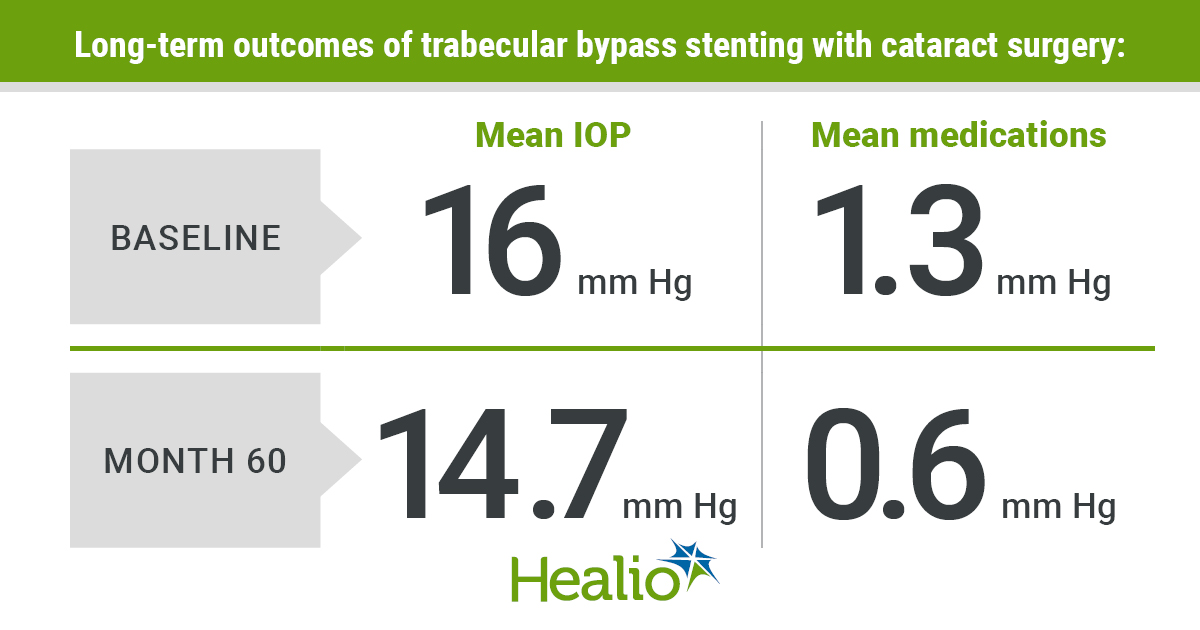Visual field, OCT outcomes stabilize after iStent implantation
Both IOP and medication use were reduced and glaucoma did not progress in the majority of patients in a study looking at 5-year visual field and OCT outcomes after iStent implantation in a real-world clinical setting.
“The iStent was able to stabilize visual field and OCT outcomes while preserving conjunctiva. This study can assist future identification of risk factors for progression,” Richard A. Lehrer, MD, said during the virtual American Society of Cataract and Refractive Surgery meeting.
Lehrer and colleagues conducted a single-surgeon retrospective case series of 220 eyes implanted with a first-generation iStent (Glaukos) and combined cataract surgery. The researchers evaluated IOP change from baseline, medication use and safety through 60 months, he said.
The mean IOP at baseline was 16.8 mm Hg, which decreased to 14.7 mm Hg by 60 months in 35 eyes. This represented a 12.5% reduction of IOP, which was statistically significant at all time points (P < .001). Medications decreased from 1.3 at baseline to 0.6 at 60 months.

At 36 months, 97.7% of 132 eyes experienced a mean IOP of 21 mm Hg or less and 51.5% experienced a mean IOP of 15 mm Hg or less. Preoperatively, 9.9% of eyes were medication-free, which increased to 63.4% by month 36.
Lehrer said 147 eyes had at least one reliable visual field at both preoperative and postoperative time points, with a mean postoperative visual field at 37.7 months. Of these eyes, 90% showed no glaucoma progression. The 10% of eyes that progressed experienced a mean change of –2.59 dB, he said.
Additionally, 204 eyes had at least one reliable OCT scan both preoperatively and postoperatively, with a mean postoperative scan at 35.7 months. Of these eyes, 93.2% showed no glaucoma progression. Eyes that progressed experienced a mean change of –5.7 µm, he said.
In total, 117 eyes had both one reliable OCT and visual field at preoperative and postoperative time points. The data showed 115 eyes experienced no progression based on both OCT and visual field scans. The two eyes that progressed were 5 years older and were more likely to have selective laser trabeculoplasty, Lehrer said.
The cohort exhibited a high safety profile, with no reports of allergy, no device-related adverse events, no intraoperative complications and no evidence of peripheral anterior synechiae; 79% of eyes did not require further glaucoma surgery. However, 20% of eyes went on to have SLT at a mean 28.1 months postoperative.
“This is significant because we can now tell our patients that between 2 and 3 years postop, they may require escalation, either in medication or further laser treatment,” he said. – by Robert Linnehan
Reference:
Lehrer RA. Long-term outcomes of trabecular bypass stenting with cataract surgery including VF, OCT and disease progression: Real-world case series. Presented at: American Society of Cataract and Refractive Surgery meeting; May 16-17, 2020 (virtual meeting).
Disclosure: Lehrer reports he is a consultant and speaker for Glaukos and a consultant for Ivantis and Ocular Therapeutix.










